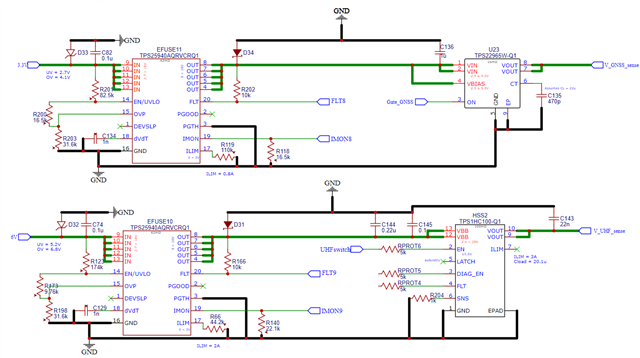Other Parts Discussed in Thread: TPS1HC100-Q1
Hi,
Customer have confirmation regarding their design, please see details below.

Preface:
Based from "Basics of Power Switches" application report, I have designed these for my 2 subsystems: GNSS and UHF. Peak currents are (1.8W/3.3V) 0.54A and (10W/6V) 1.66A, respectively. Cload of UHF is confirmed to be such while Cload of GNSS is only assumed (I have no explicit value for Cload but they only told me that inrush current = 1.75A for 1.5ms only (https://docs.novatel.com/OEM7/Content/Technical_Specs_Receiver/OEM719_Electric_Environment_Specs.htm?tocpath=Specifications%7COEM719%20Technical%20Specifications%7C_____3)).
Questions:
1. For UHF, since both efuse and high-side switch has current limit capability, I only employed this capability in the efuse and not in the HSS. I did this to reduce component count and save board space. Is this assured design? Is it better to implement current limit for HSS as well? I have no PCB layout yet for this. Please ignore HSS pins 2-6 for now.
2. For UHF, I defined the current limit to be 2A as a gut feeling only. I tried backing this up by computing for the Δt in the "inrush current" equation since I know Cload value. Δt = 20.1u (6 - 1.66*0.1)/ILIM = 117.263e-6 / ILIM. Ignoring specific application requirements such as system startup timing, how do I objectively know a good Δt (so I can know a good ILIM)?
3. For GNSS, the company informed me that inrush current = 1.75A for 1.5ms only. Since I plan to use a load switch, I understand that the inrush current is mitigated by adjusting the rise time using capacitor CT. In my design, I implemented a value of 470p for now. While the efuse implements a 0.8A current limit. I was wondering how can I solve for capacitor CT?
4. For GNSS, given what the company told me about the inrush current, is a load switch even the better option than HSS? I tentatively chose a load switch after thinking that the capacitive load isn't that high for GNSS (which I have no idea for now) and that the RDS_ON of the load switch is lower than any automotive-rated HSS.
Please let me know what you guys think.
"
Thank you in advance.
Regards,
May



